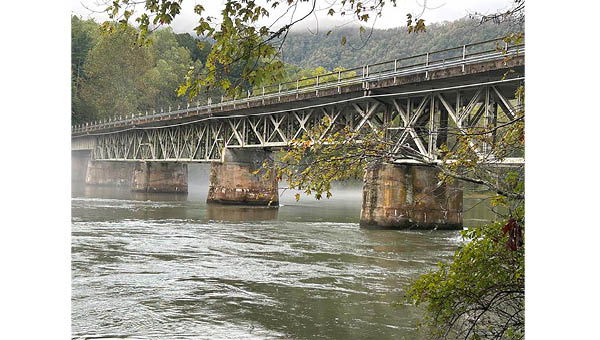Overmountain Victory Trail is an important piece of local history
Published 2:00 pm Friday, September 6, 2024
|
Getting your Trinity Audio player ready...
|
An important weekend is coming up at Sycamore Shoals State Historic Park. Saturday, Sept. 14, the annual Gathering at Sycamore Shoals State Park will take place at 10 a.m. The Tennessee Society Sons of the American Revolution will gather at Fort Watauga in honor of the Overmountain Men and their victory over loyalist forces at the Battle of Kings Mountain. It will be the 24th anniversary of the “Gathering” and will be celebrated with a memorial service and a ceremonial wreath laying.
And, the following weekend – Sept. 21 and 22 – will be the Overmountain Muster at Sycamore Shoals to be followed on Sept. 25 by the OVTA Watauga River Crossing. Members of the Overmountain Victory Trail Association have recreated the historic mark to Kings Mountain since 1975. On that date marchers will cross the Watauga River at Sycamore Shoals, just as the Overmountain Militia crossed 244 years ago. Following the cross, members of the OVTA will meet inside Fort Watauga as they share the story of the Campaign to Kings Mountain and the patriot victory that turned the tide of the American Revolution.
The Sycamore Shoals events are an important piece of local history. In the fall of 1780, during the Revolutionary War, the American fight for independence was struggling. British Major Patrick Ferguson demanded allegiance to the King of England from the people living in the Carolina backcountry and the Appalachians. Referred to as the Overmountain area, these settlements were west of, or “over” the Appalachian Mountains. At that time, this was the boundary dividing the 13 American colonies from the western frontier. The Overmountain area included parts of North Carolina, Virginia, and what is now Tennessee.
Trending
The Overmountain Men were originally reluctant to pick up arms for the Patriot cause. But when British Major Ferguson threatened to bring his army across the mountain to “hang their leaders, and lay waste to the land with fire and sword” if they did not swear allegiance to the King, the Overmountain Men were outraged.
They decided to organize an attack against Major Ferguson. Troops were gathered in Sycamore Shoals, an outpost on the Watauga River, near present day Elizabethton. They then rode to the mountains of North Carolina.
On the evening of September 28, nearly 1,000 rifle-armed, mounted militiamen reached the fields along Grassy Creek, N.C. These Overmountain soldiers were under the command of Colonel Isaac Shelby, Colonel John Sevier, Colonel William Campbell and Colonel Charles McDowell. They had completed a hard 20-mile ride that day from the top of snow-covered Yellow Mountain, following Bright’s Trace along the North Toe River to the mouth of Grassy Creek, near the modern-day town of Spruce Pine, N.C.
At Grassy Creek, they found an excellent place to make camp with plenty of fresh water available for the men and their horses. Over their campfires, they prepared a simple meal of parched corn and finished off the last of their beef rations. The next morning the officers formed their men up, ordered them to mount their horses, and rode out of camp.
Half the men rode with Colonel Campbell across the Blue Ridge through Gillespie and Lynn Gaps into Turkey Cove to seek out intelligence from suspected Loyalist Henry Gillespie. They crossed the crest of the Blue Ridge Mountains near the town of Spruce Pine, N.C. On the night of September 29, they camped near the present-day site of the Museum of North Carolina Minerals (Milepost 331) on the Blue Ridge Parkway.
The other half of the men, under Colonel Shelby and Colonel Sevier, returned to the North Toe River and followed Roses Creek to Hefner Gap, where they crossed the Blue Ridge and descended into North Cove.
Trending
The battle between Major Ferguson’s British troops and the Overmountain Men took place on October 7, 1780 at King’s Mountain, S.C. The Overmountain Men used silence and stealth as they ascended the ridge of King’s Mountain to surprise the enemy. The battle lasted only an hour. Afterwards, over 200 British soldiers lay dead, including Major Ferguson. Another 160 were wounded and roughly 700 prisoners had been taken.
The crucial Patriot victory at the Battle of King’s Mountain turned the tide of the Revolutionary War and set the nation on the road to independence.
Today, stretching 330 miles through four states (Virginia, Tennessee, North and South Carolina) the Overmountain Victory National Historic Trail traces the route used by patriot militia during the pivotal Kings Mountain campaign of 1780.
One of the men who fought long and hard to have the Overmountain Victory Trail designated a national historic trail was the late Thomas Gray of Elizabethton.
Gray was among a local group of dedicated people inspired by the late Judge Ben Allen, who staged the first re-enactment of the 1780 Overmountain March.
Their goal was to gain national recognition for the OVT by 1980 – the 200th anniversary of the famous march, and from there the march became an annual event.
In 1978 the Congress authorized a feasibility study of the trail and its importance to history, after which a positive recommendation was sent to Congress and in 1980 legislation was passed making the OVT a national trail, and it was signed into law by the president.
In addition to Gray, among local hikers on that first re-enactment march were David Yates, the youngest boy participating in the march, and Charles LaPorte and Mark and Kazel LaPorte.
In the years to follow Jack Stansberry along with Sycamore Shoals Park directors, Herb Roberts and Jennifer Bauer, have been actively involved in the annual march and celebration.
As dramatic and exhilarating as is the tale of the Overmountain militia’s arduous journey and the Battle of Kings Mountain – and despite the recognition by Congress and efforts to raise awareness about their feats of daring and endurance – it doesn’t get nearly the attention it deserves.
In fact, most people outside the region where the events transpired probably haven’t even heard of it.
What people don’t realize is that there were more Revolutionary War battles fought in the American South than anywhere else. When the British decided to move South, it was a big mistake. They fought Washington up north for five years, but in the South they got whipped in just a year and 12 days.
Another reason this is the most untold story is simply because it wasn’t the Continental Army that defeated the British in the South – it was mostly backwoodsmen.
Sycamore Shoals and the Overmountain Victory Trail are important pieces of local history that must be told and re-told. It is the story of America’s freedom.





